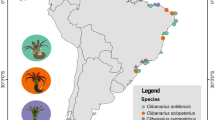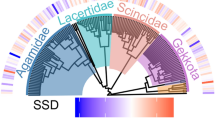Abstract
Sexual size dimorphism might be influenced by environmental constraints on sexual selection or by intraspecific competition between males and females. We studied bobcats (Lynx rufus) in collections of museum specimens from western North America to examine these hypotheses. Structural body size was estimated from several measurements of the skull, ln-transformed and indexed through principal components analysis. Sexual dimorphism in body size was estimated from the difference in size index of males and females, and compared to geographic and climatic variables associated with biotic provinces (ecoregions). Of several climatic variables that were associated with bobcat body size, only seasonality of climate was associated with sexual dimorphism. Sexual size dimorphism, longitude, elevation, and seasonality were intercorrelated. As longitude decreased (moving inland from west-coastal ecoregions), sexual dimorphism decreased with the increased elevation and seasonality of continental climates of the Rocky Mountains. We suggest that increased seasonality and the need for fasting endurance by females may place constraints on the degree of sexual dimorphism in bobcats. Sexual dimorphism of body size and sexual size dimorphism of trophic structures (teeth) exhibited a strong positive association over geography, thus indirectly supporting the hypothesis that intrasexual competition for prey could account for the geographic variation in sexual size dimorphism. Thus, both environmental constraints on sexual selection of body size and intersexual competition were supported as possible explanations of the degree of sexual size dimorphism that occurs in populations of bobcats.
Similar content being viewed by others
References
Aldrich JW, James FC (1991) Ecogeographic variation in the American robin (Turdus migratorius). Auk 108: 230–249
Arnold SJ (1983) Sexual selection: the interface of theory and empiricism. In: Bateson P (ed) Mate choice. Cambidge University Press, Cambridge, pp 67–107
Bailey RG, Cushwa CT (1982) Ecoregion, land-surface form and hydrologic unit maps of the United States. US Department of the Interior, Biological Services Program, Fish and Wildlife Service, Washington
Barnett RJ (1977) Bergmann's Rule and variation in structures related to feeding in the gray squirrel. Evolution 31: 538–545
Boyce MS (1978) Climatic variability and body size variation in the muskrats (Ondatra zibethicus) of North America. Oecologia 36: 1–19
Boyce MS (1979) Seasonality and patterns of natural selection for life histories. Am Nat 114: 569–583
Brown JH, Lee AK (1969) Bergmann's Rule and climatic adaptation in woodrats (Neotoma). Evolution 23: 329–338
Conway HM, Liston LL (1974) The weather handbook. Conway Research, Atlanta
Crowe DM (1975) Aspects of aging, growth, and reproduction of bobcats from Wyoming. J Mammal 56: 177–198
Dayan T, Simberloff D, Tchernov E, Yom-Tov Y (1989) Inter- and intraspecific character displacement in mustelids. Ecology 70: 1526–1539
Dobson FS (1992) Body mass, structural size, and life-history patterns of the Columbian ground squirrel. Am Nat 139: 109–125
Dobson FS, Michener GR (1995) Maternal traits and reproduction in Richardson's ground squirrels. Ecology 76: 851–862
Endler JA (1977) Geographic variation, speciation, and clines. Princeton University Press, Princeton
Fisher R (1958) The genetical theory of natural selection. Dover, New York
Hall ER (1981) The mammals of North America, 2nd edition. Wiley, New York
Hare FK, Thomas MK (1974) Climate Canada, Wiley, Toronto
Hedrick AV, Temeles EJ (1989) The evolution of sexual dimorphism in animals: hypotheses and tests. Trends Ecol Evol 4: 136–138
Iskjaer C, Slade NA, Childs JE, Glass GE, Korch GW (1989) Body mass as a measure of size in small mammals. J Mammal 70: 662–667
Jackson CLM (1987) Growth and development of captive bobcats (Felis rufus). M.S. thesis, Mississippi State University
James FC (1970) Geographic size variation in birds and its relationship to climate. Ecology 51: 365–390
James FC, McCulloch CE (1990) Multivariate analysis in ecology and systematics: panacea or Pandora's box? Annu Rev Ecol Syst 21: 129–166
Jandel Scientific (1992) TableCurve Windows v1.0 software. Jandel Scientific, San Rafael
Kennedy ML, Lindsay SL (1984) Morphologic variation in the raccoon, Procyon lotor, and its relationship to genic and environmental variation. J Mammal 65: 195–205
Lande R (1981) Models of speciation by sexual selection of polygenic traits. Models of speciation by sexual selection of polygenic traits. Proc Natl Acad Sci USA 78: 3721–3725
Lindstedt SL, Boyce MS (1985) Seasonality, fasting endurance, and body size in mammals. Am Nat 125: 873–878
Mayr E (1956) Geographical character gradients and climatic adaptation. Evolution 10: 105–108
McNab BK (1971) On the ecological significance of Bergmann's Rule. Ecology 52: 845–854
Millar JS, Hickling GJ (1990) Fasting endurance and the evolution of mammalian body size. Funct Ecol 4: 5–12
Nagorsen DW (1985) A morphometric study of geographic variation in the snowshoe hare (Lepus americanus). Can J Zool 63: 567–579
National Oceanic and Atmospheric Administration (1985a) Climate normals for the United States (Base: 1951–1980), 1st edn. Gale Research Company, Detroit
National Oceanic and Atmospheric Administration (1985b) Climates of the states, 3rd edn. Gale Research Company, Detroit
Owen JG (1989) Population and geographic variation of Peromyscus leucopus in relation to climatic factors. J Mammal 70: 98–109
Ralls K (1976) Mammals in which females are larger than males. Q Rev Biol 51: 245–276
Ralls K (1977) Sexual dimorphism in mammals: avian models and unanswered questions. Am Nat 111: 917–938
Ralls K, Harvey PH (1985) Geographic variation in size and sexual dimorphism of North American weasels. Biol J Linn Soc 25: 119–167
Ritke ME, Kennedy ML (1988) Intraspecific morphologic variation in the raccoon (Procyon lotor) and its relationship to selected environmental variables. Southwest Nat 33: 295–314
Rosenzweig ML (1968) The strategy of body size in mammalian carnivores. Am Midl Nat 80: 299–315
SAS Institute (1987) SAS/STAT guide for personal computers, version 6 edn. SAS Institute, Cary
Selander RK (1966) Sexual dimorphism and differential niche utilization in birds. Condor 68: 113–151
Selander RK (1972) Sexual selection and dimorphism in birds. In: Campbell BG (ed), Sexual selection and the descent of man, 1871–1971. Aldine, Chicago, pp 180–230
Sikes RS, Kennedy ML (1992) Morphologic variation of the bobcat (Felis rufus) in the eastern United States and its association with selected environmental variables. Am Midl Nat 128: 313–324
Sikes RS, Kennedy ML (1993) Geographic variation in sexual dimorphism of the bobcat (Felis rufus) in the eastern United States. Southwest Nat 38: 336–344
Sokal RR, Rohlf JF (1981) Biometry, 2nd edn. Freeman, New York
Thornthwaite Associates (1964) Publications in climatology. Average climatic water balance data of the continents, part VII, United States. Laboratory of Climatology publication 17. Centerton, New Jersey, pp 419–615
Wigginton JD (1992) Geographic variation of the bobcat (Felis rufus) in relation to environmental variables. M.S. thesis, Auburn University, Auburn
Zimmerman OT, Lavine I (1964) Psychometric tables and charts. Industrial Research Service, Dover, New Hampshire
Author information
Authors and Affiliations
Corresponding author
Rights and permissions
About this article
Cite this article
Dobson, F.S., Wigginton, J.D. Environmental influences on the sexual dimorphism in body size of western bobcats. Oecologia 108, 610–616 (1996). https://doi.org/10.1007/BF00329033
Received:
Accepted:
Issue Date:
DOI: https://doi.org/10.1007/BF00329033




